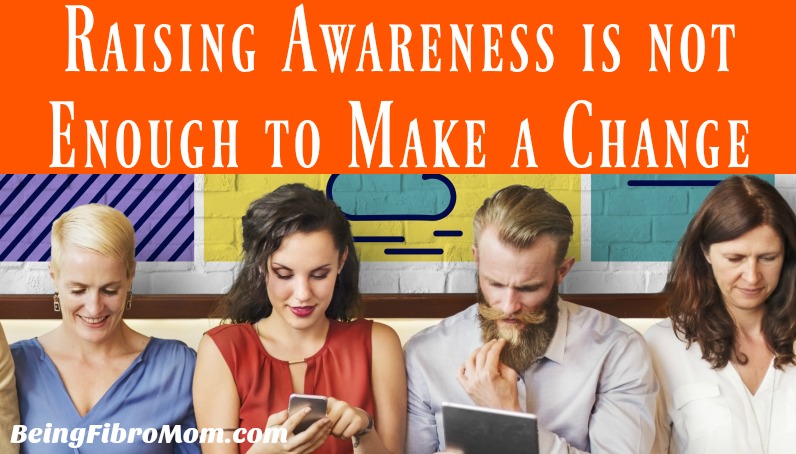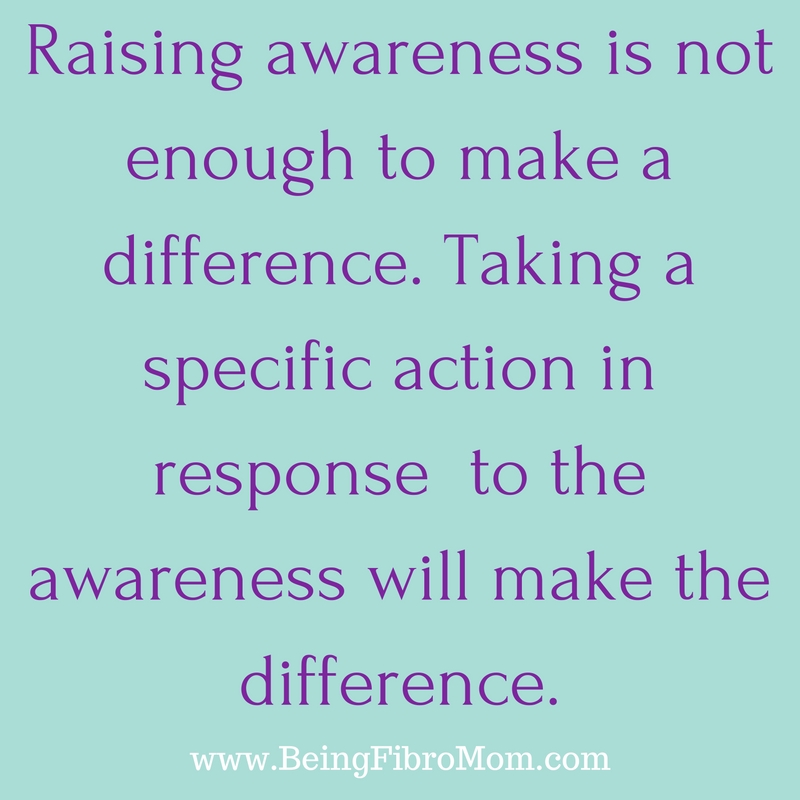Raising awareness is not enough to make a change. There are steps we can take with the awareness to make the changes we need. So why isn’t raising awareness enough to make a change? Here’s an inside look at awareness campaigns and what happens when the campaigns are over.

This article first appeared in The Fibromyalgia Magazine, September 2016. Get the digital copy of the magazine from Pocketmags.
Fibromyalgia Awareness
September is Fibromyalgia Awareness in the United Kingdom, and the Fibromyalgia community gathers in a joint effort to promote awareness of the debilitating illness. We rally together with purple ribbons, walks, and purple lights to show strength in numbers. Some use the power of social media to educate others about fibromyalgia through the use of videos, photos, and other forms of media.
With all the effort put into raising awareness, we have to ask –
Are campaigns having any direct, positive impact?
What are the effects of the campaigns?
What good is raising awareness?
According to the article What Good is Raising Awareness? by Julie Beck of The Atlantic, there is lacking evidence of the impact of awareness days. Studies have been conducted to measure the effectiveness, but data is inconclusive. A range of experts that were interviewed for the article stated that most awareness campaigns failed because they only released general information about the issue while other campaigns failed because the effects of the campaign did the opposite of their intention.
This leads to the next question –
Is providing information enough to impact a person’s change in behavior in regards to the topic of the campaign?
Raising Awareness is NOT Enough
No. Providing information alone is not enough. Jonathon Purtle, an assistant professor at Drexel University’s School of Public Health, and Leah Roman, a public-health consultant in the United States, both interviewed in What Good is Raising Awareness, stated that an unintentional effect of awareness days is narcotizing dysfunction – as people gain more knowledge of a concerning issue, the chances that they take actions to help the issue decline.
Putting out information to others for awareness is only the first step of a two-step process in changing a person’s behavior towards a concerning issue. Asking people to take a specific action in light of the knowledge is the second step (this is also known as advocacy).

Call to Action Items
There are ten simple actions you can ask others to take when spreading awareness of fibromyalgia.
- Encourage local leaders and public officials to become involved with campaigns by delivering a message via media and/or declaring an official awareness day for the local community. Inform them of the importance of spreading fibromyalgia awareness and the power of their presence with that message.
- Show support for someone with fibromyalgia.
- Share information about local fibromyalgia support groups via social media, local media, or word of mouth. Gathering and distributing information about local groups can be valuable to someone that may not know how to retrieve that information.
- Be cautious about giving an organization money without knowing how the funds are disbursed. Find the specific facility where the funds are going and how the funds are distributed within that facility. A good organization will have a breakdown of where the raised money is going and for what research projects they are being used.
- When talking with someone that has fibromyalgia, be open-minded about their illness. Show genuine interest in what they are saying by using positive body language such as making eye contact and not crossing your arms. Being sympathetic, not pitying, can make a difference to someone suffering from fibromyalgia.
- When sharing information via social media about fibromyalgia, tailor it to your audience for the message to be better received.
- Pass out informative brochures, flyers, magnets, or fact sheets about the seriousness of fibromyalgia and actions that can be taken to support someone with fibromyalgia. To get more information and literature, contact an organization – such as the International Support Fibromyalgia Network – that specializes in fibromyalgia. Most organizations are happy to provide handouts for raising awareness.
- Host an event that encourages the support of fibromyalgia thrivers (formerly known as sufferers). For example, host a potluck in your community and invite local fibro thrivers and their families. Providing literature or other information about fibromyalgia is great, but not a necessity. Having a social gathering of local thrivers and their families encourages talk about fibromyalgia resulting in the foundations of an effective support system within the community.
- Lastly, communicate openly about the illness. Tell your story whether you are the fibromyalgia thriver, caregiver, friend, or family member. Letting others know that they are not alone and that others are willing to fight for self-preservation will give them the courage to help them in thriving fibromyalgia.
Do your part
Simply raising awareness is not enough. We need to ask others to take action to change the thinking, diagnosing, and treatment of fibromyalgia. Though social media is the communication vehicle carrying information about the illness and its complexity all over the world, each individual must do their part to spread the message to their loved ones, friends, and beyond. It may be clichéd, but it’s a fit for this message – knowledge is power, but actions speak louder than words.

Pingback: Shine For Fibro - Being Fibro Mom fibromyalgia